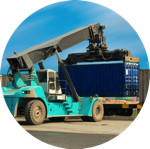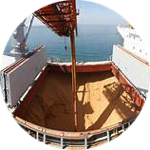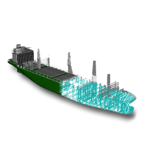
Loading A Container
Bulk Mass Materials
Hull Compartments
The whole conveying route from the ship hatch through the unloader up to the pier conveyor is enclosed
Loading Pellets
The pellets are loaded layer by layer into the hull
Transport Around The Globe
These unloader types permit the effective, dust-free and low-noise unloading of biomass pellets.
Ship Hulls And Pellet Fuel





Ship Hull Unloading machines can unload 2,000 tons of pellets and or coal per hour from ships with deadweight capacities of between 50,000 and 150,000 tons.
These new unloaders are characterized by eco-friendly and continuous transportation of material from the hull of the ship up to the pier conveyor. The fuel, which is picked up in the horizontal section of the L-shaped bucket elevator, is transferred to the boom belt of the ship unloader via a rotating distributor on the bucket elevator head. From there the fuel material flows through the center of the machine on an intermediate conveyor which acts as a link to the pier conveyor. Ensuring the stability and reliability of the system is always a particular focus of development work due to the in part extreme weather conditions in harbor loading and unloading regions. The whole conveying route from the ship hatch through the unloader up to the pier conveyor is enclosed, meaning that there is only limited dust or material spillage, even in strong winds.
The longitudinal axis of the unloader conveyor can be moved in three dimensions. The lifting and slewing movement of the entire boom and the fact that the bucket elevator can be rotated through 360 degrees ensure that all the coal deposits can be collected from a ship hatch, even those close to the floor and sides of the hull. The operator of the unloader is supported by a computer-aided unloading (CAU) function. In an automated operation, the pellets are removed layer by layer down to the floor of the hull. An additional mobile device is then only needed at a later stage to collect residues. The mobile device is lifted from the pier into the hatch from an attachment point on the base of the bucket elevator and then moved to other hatches on completion of its work. The ship unloader can be operated from the cab on the boom head or remotely from the pier or ship’s hatch.
Use of continuous systems for bulk material unloading is on the increase, especially in the medium- to high-output ranges. These unloader types permit the effective, dust-free and low-noise unloading of biomass pellets, coal, ores, phosphates, sulfur, fertilizers and other bulk materials from ships.